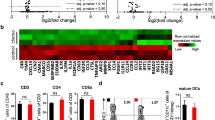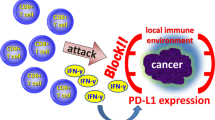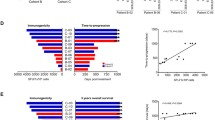Abstract
Immune-based therapies that induce remarkable and durable responses against melanoma and lung cancer have unfortunately demonstrated limited success in ovarian cancer patients. This is likely due to the exceptional immunoregulatory nature of ovarian tumors, which employ numerous strategies to effectively suppress anti-tumor immunity. Here, we summarize a decade of research indicating that ovarian cancers possess an exquisite capacity to subvert the activity of host dendritic cells (DCs) as a key mechanism to impede the development and maintenance of protective T cell-based immune responses. Identifying, understanding, and disabling the precise mechanisms promoting DC dysfunction in ovarian cancer are, therefore, fundamental requirements for devising the next generation of successful immunotherapies against this devastating malignancy.


Similar content being viewed by others
Abbreviations
- 4-HNE:
-
4-Hydroxynonenal
- BMDC:
-
Bone marrow-derived DC
- CCL3:
-
Chemokine (C-C motif) ligand 3
- CCL5:
-
Chemokine (C-C motif) ligand 5
- CCR6:
-
Chemokine receptor 6
- cDC:
-
Conventional DCs
- CRISPR/Cas9:
-
Clustered regularly interspaced short palindromic repeats/CRISPR-associated protein 9
- CTLA4:
-
Cytotoxic T-lymphocyte-associated antigen 4
- DC:
-
Dendritic cell
- ER:
-
Endoplasmic reticulum
- IFN:
-
Interferon
- IRE1α:
-
Inositol-requiring enzyme 1
- miRNA:
-
MicroRNA
- MyD88:
-
Myeloid differentiation primary response gene 88
- PD-1:
-
Programmed cell death protein 1
- PD-L1:
-
Programmed cell death protein ligand 1
- pDC:
-
Plasmacytoid dendritic cells
- PEI:
-
Polyethylenimine
- PGE2:
-
Prostaglandin E2
- PIGF-1:
-
Placenta growth factor
- ROS:
-
Reactive oxygen species
- SATB1:
-
Special AT-rich sequence-binding protein-1
- sgRNA:
-
Single-guide RNA
- siRNA:
-
Small-interfering RNA
- tDC:
-
Tumor-associated DC
- TGF-β:
-
Tumor growth factor -β
- Th1:
-
T helper 1
- TLR:
-
Toll-like receptor
- TNF:
-
Tumor necrosis factor
- VEGF-A:
-
Vascular Endothelial Growth Factor-A
- XBP1:
-
X-box-binding protein 1
References
Siegel RL, Miller KD, Jemal A (2016) Cancer statistics, 2016. CA Cancer J Clin 66(1):7–30
Matulonis UA et al (2016) Ovarian cancer. Nat Rev Dis Primers 2:16061
Giornelli GH (2016) Management of relapsed ovarian cancer: a review. SpringerPlus 5(1):1197
Zhang L et al (2003) Intratumoral T cells, recurrence, and survival in epithelial ovarian cancer. N Engl J Med 348(3):203–213
Nesbeth Y et al (2009) CCL5-mediated endogenous antitumor immunity elicited by adoptively transferred lymphocytes and dendritic cell depletion. Cancer Res 69(15):6331–6338
Nesbeth YC et al (2010) CD4 + T cells elicit host immune responses to MHC class II-negative ovarian cancer through CCL5 secretion and CD40-mediated licensing of dendritic cells. J Immunol 184(10):5654–5662
Conejo-Garcia JR et al (2004) Tumor-infiltrating dendritic cell precursors recruited by a beta-defensin contribute to vasculogenesis under the influence of Vegf-A. Nat Med 10(9):950–958
Barnett B et al (2005) Regulatory T cells in ovarian cancer: biology and therapeutic potential. Am J Reprod Immunol 54(6):369–377
Curiel TJ et al (2003) Blockade of B7-H1 improves myeloid dendritic cell-mediated antitumor immunity. Nat Med 9(5):562–567
Huarte E et al (2008) Depletion of dendritic cells delays ovarian cancer progression by boosting antitumor immunity. Cancer Res 68(18):7684–7691
Cubillos-Ruiz JR et al (2009) Polyethylenimine-based siRNA nanocomplexes reprogram tumor-associated dendritic cells via TLR5 to elicit therapeutic antitumor immunity. J Clin Invest 119(8):2231–2244
Pardoll DM (2012) The blockade of immune checkpoints in cancer immunotherapy. Nat Rev Cancer 12(4):252–264
Sharma P, Allison JP (2015) Immune checkpoint targeting in cancer therapy: toward combination strategies with curative potential. Cell 161(2):205–214
Morgan RA et al (2006) Cancer regression in patients after transfer of genetically engineered lymphocytes. Science 314(5796):126–129
Dudley ME et al (2002) Cancer regression and autoimmunity in patients after clonal repopulation with antitumor lymphocytes. Science 298(5594):850–854
Hamanishi J et al (2015) Safety and antitumor activity of anti-PD-1 antibody, nivolumab, in patients with platinum-resistant ovarian cancer. J Clin Oncol 33(34):4015–4022
Kershaw MH et al (2006) A phase I study on adoptive immunotherapy using gene-modified T cells for ovarian cancer. Clin Cancer Res 12(20 Pt 1):6106–6115
Kandalaft LE et al (2013) Autologous lysate-pulsed dendritic cell vaccination followed by adoptive transfer of vaccine-primed ex vivo co-stimulated T cells in recurrent ovarian cancer. Oncoimmunology 2(1):e22664
Geissmann F et al (2010) Development of monocytes, macrophages, and dendritic cells. Science 327(5966):656–661
Mildner A, Jung S (2014) Development and function of dendritic cell subsets. Immunity 40(5):642–656
Takizawa H, Boettcher S, Manz MG (2012) Demand-adapted regulation of early hematopoiesis in infection and inflammation. Blood 119(13):2991–3002
Gabrilovich DI, Ostrand-Rosenberg S, Bronte V (2012) Coordinated regulation of myeloid cells by tumours. Nat Rev Immunol 12(4):253–268
Ostrand-Rosenberg S, Sinha P (2009) Myeloid-derived suppressor cells: linking inflammation and cancer. J Immunol 182(8):4499–4506
Conejo-Garcia JR, Rutkowski MR, Cubillos-Ruiz JR (2016) State-of-the-art of regulatory dendritic cells in cancer. Pharmacol Ther 164:97–104
Scarlett UK et al (2009) In situ stimulation of CD40 and Toll-like receptor 3 transforms ovarian cancer-infiltrating dendritic cells from immunosuppressive to immunostimulatory cells. Cancer Res 69(18):7329–7337
Scarlett UK et al (2012) Ovarian cancer progression is controlled by phenotypic changes in dendritic cells. J Exp Med 209(3):495–506
Munder M, Arginase (2009) an emerging key player in the mammalian immune system. Br J Pharmacol 158(3):638–651
Cubillos-Ruiz JR et al (2010) CD277 is a negative co-stimulatory molecule universally expressed by ovarian cancer microenvironmental cells. Oncotarget 1(5):329–338
Liu HT, Gao P (2016) The roles of microRNAs related with progression and metastasis in human cancers. Tumor Biol 37(12):15383–15397. doi:10.1007/s13277-016-5436-9
Rodriguez A et al (2007) Requirement of bic/microRNA-155 for normal immune function. Science 316(5824):608–611
Cubillos-Ruiz JR et al (2012) Reprogramming tumor-associated dendritic cells in vivo using miRNA mimetics triggers protective immunity against ovarian cancer. Cancer Res 72(7):1683–1693
Zonari E et al (2013) A role for miR-155 in enabling tumor-infiltrating innate immune cells to mount effective antitumor responses in mice. Blood 122(2):243–252
Tesone AJ et al (2016) Satb1 overexpression drives tumor-promoting activities in cancer-associated dendritic cells. Cell Rep 14(7):1774–1786
Cubillos-Ruiz JR et al (2015) ER stress sensor XBP1 controls anti-tumor immunity by disrupting dendritic cell homeostasis. Cell 161(7):1527–1538
Hetz C, Chevet E, Harding HP (2013) Targeting the unfolded protein response in disease. Nat Rev Drug Discov 12(9):703–719
Yoshida H et al (2001) XBP1 mRNA is induced by ATF6 and spliced by IRE1 in response to ER stress to produce a highly active transcription factor. Cell 107(7):881–891
Lee AH, Iwakoshi NN, Glimcher LH (2003) XBP-1 regulates a subset of endoplasmic reticulum resident chaperone genes in the unfolded protein response. Mol Cell Biol 23(21):7448–7459
Tang CH et al (2014) Inhibition of ER stress-associated IRE-1/XBP-1 pathway reduces leukemic cell survival. J Clin Invest 124(6):2585–2598
Chen X et al (2014) XBP1 promotes triple-negative breast cancer by controlling the HIF1alpha pathway. Nature 508(7494):103–107
Auf G et al (2010) Inositol-requiring enzyme 1alpha is a key regulator of angiogenesis and invasion in malignant glioma. Proc Natl Acad Sci USA 107(35):15553–15558
Dalton LE et al (2013) The endoplasmic reticulum stress marker CHOP predicts survival in malignant mesothelioma. Br J Cancer 108(6):1340–1347
Davies MP et al (2008) Expression and splicing of the unfolded protein response gene XBP-1 are significantly associated with clinical outcome of endocrine-treated breast cancer. Int J Cancer 123(1):85–88
Matsuo K et al (2013) The endoplasmic reticulum stress marker, glucose-regulated protein-78 (GRP78) in visceral adipocytes predicts endometrial cancer progression and patient survival. Gynecol Oncol 128(3):552–559
Herber DL et al (2010) Lipid accumulation and dendritic cell dysfunction in cancer. Nat Med 16(8):880–886
Condamine T et al (2016) Lectin-type oxidized LDL receptor-1 distinguishes population of human polymorphonuclear myeloid-derived suppressor cells in cancer patients. Sci Immunol 1(2):aaf8943
Schoenberger SP et al (1998) T-cell help for cytotoxic T lymphocytes is mediated by CD40–CD40L interactions. Nature 393(6684):480–483
Bennett SR et al (1998) Help for cytotoxic-T-cell responses is mediated by CD40 signalling. Nature 393(6684):478–480
Beatty GL et al (2011) CD40 agonists alter tumor stroma and show efficacy against pancreatic carcinoma in mice and humans. Science 331(6024):1612–1616
Vonderheide RH et al (2013) CD40 immunotherapy for pancreatic cancer. Cancer Immunol Immunother 62(5):949–954
Marigo I et al (2016) T cell cancer therapy requires CD40-CD40L activation of tumor necrosis factor and inducible nitric-oxide-synthase-producing dendritic cells. Cancer Cell 30(3):377–390
Beatty GL et al (2013) A phase I study of an agonist CD40 monoclonal antibody (CP-870,893) in combination with gemcitabine in patients with advanced pancreatic ductal adenocarcinoma. Clin Cancer Res 19(22):6286–6295
Rosenfeld MR et al (2010) A multi-institution phase II study of poly-ICLC and radiotherapy with concurrent and adjuvant temozolomide in adults with newly diagnosed glioblastoma. Neuro Oncol 12(10):1071–1077
Hillaireau H, Couvreur P (2009) Nanocarriers’ entry into the cell: relevance to drug delivery. CMLS Cell Mol Life Sci 66(17):2873–2896
Cubillos-Ruiz JR, Fiering S, Conejo-Garcia JR (2009) Nanomolecular targeting of dendritic cells for ovarian cancer therapy. Future Oncol 5(8):1189–1192
Gaj T, Gersbach CA, Barbas CF 3rd (2013) ZFN, TALEN, and CRISPR/Cas-based methods for genome engineering. Trends Biotechnol. 31(7):397–405
Platt RJ et al (2014) CRISPR-Cas9 knockin mice for genome editing and cancer modeling. Cell 159(2):440–455
Acknowledgements
Our research has been supported by the John H. Copenhaver, Jr. and William H. Thomas, MD 1952 Fellowship of the Geisel School of Medicine at Dartmouth (Juan R. Cubillos-Ruiz), the Irvington Institute Fellowship Program of the Cancer Research Institute (Juan R. Cubillos-Ruiz), the Ann Schreiber Mentored Investigator Award of the Ovarian Cancer Research Fund Alliance (Juan R. Cubillos-Ruiz), and the Ovarian Cancer Academy—Early Career Investigator Award of the Department of Defense (Juan R. Cubillos-Ruiz). We apologize to colleagues whose work was not cited in this review due to space limitations.
Author information
Authors and Affiliations
Corresponding author
Ethics declarations
Conflict of interest
Juan R. Cubillos-Ruiz is co-founder and scientific advisor for Quentis Therapeutics, Inc. The other authors declare no conflict of interest.
Additional information
This paper is a Focussed Research Review based on a presentation given at the conference Regulatory Myeloid Suppressor Cells: From Basic Discovery to Therapeutic Application which was hosted by the Wistar Institute in Philadelphia, PA, USA, 16th–19th June, 2016. It is part of a Cancer Immunology, Immunotherapy series of Focussed Research Reviews.
Rights and permissions
About this article
Cite this article
Chae, CS., Teran-Cabanillas, E. & Cubillos-Ruiz, J.R. Dendritic cell rehab: new strategies to unleash therapeutic immunity in ovarian cancer. Cancer Immunol Immunother 66, 969–977 (2017). https://doi.org/10.1007/s00262-017-1958-2
Received:
Accepted:
Published:
Issue Date:
DOI: https://doi.org/10.1007/s00262-017-1958-2




